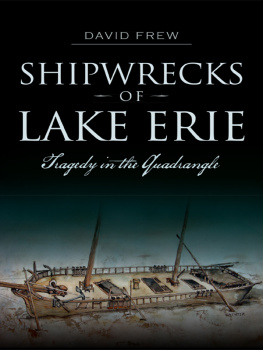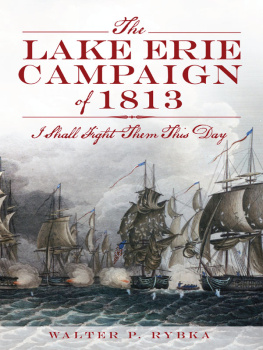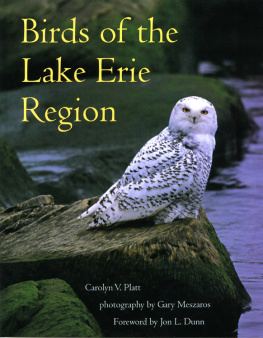

Published by The History Press
Charleston, SC 29403
www.historypress.net
Copyright 2014 by David Frew
All rights reserved
Cover image courtesy of Georgann S. Wachter, www.eriewrecks.com.
First published 2014
e-book edition 2014
ISBN 978.1.62585.085.0
Library of Congress Cataloging-in-Publication Data
Frew, David R.
Shipwrecks of Lake Erie : tragedy in the quadrangle / David Frew.
pages cm
Includes bibliographical references and index.
print edition ISBN 978-1-62619-551-6
1. Shipwrecks--Erie, Lake--History. 2. Erie, Lake--History. I. Title.
F555F74 2014
910.917712--dc23
2014014069
Notice: The information in this book is true and complete to the best of our knowledge. It is offered without guarantee on the part of the author or The History Press. The author and The History Press disclaim all liability in connection with the use of this book.
All rights reserved. No part of this book may be reproduced or transmitted in any form whatsoever without prior written permission from the publisher except in the case of brief quotations embodied in critical articles and reviews.
To my wife, Mary Ann Frew, my longtime academic colleague, writing partner and best friend.
CONTENTS
PREFACE
THE LAKE ERIE QUADRANGLE
Twenty years ago, a remarkable series of events altered my life. Like most university professors, I was engaged in the writing of grants, journal articles and textbooks, but as career enhancing as these projects were, there was something missing. The articles often resulted in snarky bickering by colleagues who disagreed with esoteric points, and while I had achieved success as a textbook writer, there is nothing as dull as editing and revising textbooks. As an added frustration, my choice of working at a medium-sized university, not known as a major research mill, often influenced the struggle to find grant funds.
Then, in a strange set of circumstances that connected my love of sailing and Lake Erie with academics, I fell into the company of a character from Ontario who was called the Beachcomber of Long Point. Dave Stone, who was old enough to be my father, had carved out a niche among shipwreck enthusiasts by virtue of episodic beach deposits that appeared near his summer home on the base of Long Point, Ontario. When something interesting washed up, he dedicated countless hours to trying to determine where it came from. During an era that preceded the sophistication that currently surrounds diving and wreck hunting, his methodology involved waiting for Lake Erie storms and then watching as shipwreck debris washed ashore. The twenty-five-mile Long Point beachfront served as a collector for bits of shipwrecks that rose to the surface during storms, and when such debris appeared, Dave would try to identify it, date it and then determine where it had come from based on wind and wave conditions. Using this crude technology, he would launch one of his two boats and try to track down the underwater location of the wreck that had shed the debris.

Lake Erie, the setting for shipping, shipwrecks and adventure, contained the busiest trade route in the world during the late 1800s. Courtesy of Jerry Skrypzak.
Daves work attracted the attention of an Ontario publishing house, which persuaded him to write a book entitled Long Point: Last Port of Call. While Dave was a true characterof the type made famous by the Captain Quint role that actor Robert Shaw played in the film classic Jawshe was neither a writer nor a skillful organizer. And yet the book was successful by virtue of the subject matter. Dave often referred to the year that it took him to write his book as a living hell from which he thought he would never be released. When we met, he told me that he would never take on another writing project, but he also expressed disappointment for not properly organizing his book and for leaving some of the best stories out.
I was drawn to Dave Stone, and as our friendship grew, I began to accompany him on shipwreck-hunting adventures. But as we began to spend time hunting shipwrecks, Dave seemed to become ill. He lost fifty pounds and began to hack and cough, not entirely surprising considering that he was a chain smoker. Convinced that the illness was going to consume him, I began to talk with him about collaborating on another book. I argued that the two of us could make short work of a bigger book with a U.S. publisher and that with his stories and my writing and research skills, his wisdom could find a larger audience. As we talked about his fragile health, I struggled to convince him that as the guru of Lake Erie shipwrecks, he couldnt allow his stories to disappear. By the time he agreed, I had secured a grant to help fund the research and a regional publisher.
Our book, The Lake Erie Quadrangle: Waters of Repose, was released in late 1993, just in time for the holiday season, and it was a hit. Almost overnight, Dave Stone and I were celebrated as the perfect pair of authors: the old-timer with stories coupled with an academic protg who could do research. The book was a regional bestseller, and it won national and state history awards. But the best outcome was Dave Stones health. Apparently, the new excitement was the tonic that he needed. His health rebounded, and while he never regained the weight that he lost, his energy and enthusiasm returned.
As I wrote Lake Erie Quadrangle, which was well out of my academic discipline (organizational psychology), I considered the project to be a onetime departure and planned to make a quick return to my traditional work on leadership and management. But as the book moved forward, its inertia resulted in offers to do more stories on Lake Erie ships, shipping and shipwrecks. While Dave Stone steadfastly refused to become involved in other writing projects and contented himself with touring to talk about our Quadrangle adventures, I semi-reluctantly began to work on more shipwreck adventures. A series of five books called the Quadrangle Series followed, as did four large-format pictorial books.
In 2008, I found my way to Hannah Cassilly and The History Press, where I developed my most historically oriented work to date, Perrys Lake Erie Fleet, a narrative dealing with the War of 1812 fleet that was stationed in Erie. The emphasis was on the largely untold events that happened after the 1813 Battle of Lake Erie. In speaking to Hannah at The History Press after that book was completed, she suggested that I write a new book about Lake Erie shipwrecks, and I mulled over the prospect. I had no interest in reworking old stories, but there was a bothersome aspect of the Quadrangle project. In working with an established database, as I had been advised to do by academic historians, I had inadvertently missed several important details. While the Lloyds of London actuarial database that we used to list the wrecks helped to anchor the previously disjointed work of Dave Stone in an objective system of qualitative research that could be defended on an academic basis, the data that we used did not include commercial fishing, yachting, excursion boats or other unreported tragedies.
The more I considered the opportunity to revisit the Lake Erie Quadrangle and take the opportunity to update the research and stories that Dave Stone and I told twenty years ago, the more exciting the project began to seem. And so, I offer a fresh look at the shipwrecks of Lake Erie and new twists on old stories, as well as a tribute to my friend, the Beachcomber of Long Point, who passed away a few years ago.
Next page









